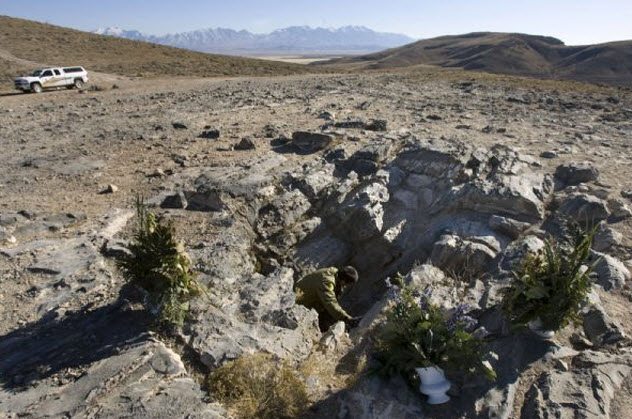Accidents, where the victims could not be partially blamed, are uncommon because the leading cause of death in these cases is bad decision-making. Think before you act. Also, check out the entries below for tips on how you might survive some of these deadly ways of getting stuck.
10 Chimney
Although claustrophobia is not related to Santa Claus, it can become oddly fitting when rescuing people who are stuck in chimneys. In most cases, however, people have much darker intentions than leaving presents under the Christmas tree. Cartoons and fairy tales may have misled people into believing that you can slide down a chimney with ease. In actuality, chimneys are death traps. Several burglars have learned that the hard way. One such example was a man who was found stuck in the chimney when the homeowner lit the fireplace and heard sudden screams. After extinguishing the fire, he called the authorities. The suspected burglar was dead by the time firefighters got to him.[1] In a different case, a doctor was found lodged in her boyfriend’s chimney. She had attempted to forcefully enter the house while her boyfriend was away on a trip. A house sitter, who had stopped by to feed the owner’s fish, found her corpse after investigating a strong odor coming from the fireplace. Typical chimney designs have 1–3 bends or elbows, which can completely stop a person’s descent. Also, the flue at the bottom of the chimney tends to be narrower to ensure quicker smoke movement. This makes getting through highly unlikely. Chimney-related accidents were especially common in 18th- and 19th-century Britain when chimney sweepers were in fashion. Children usually performed this work and often died because of positional asphyxia, in which body contortion prevents the normal breathing motions of the diaphragm. Until 1885, the word “stick” did not technically mean the inability to go any farther. So it is possible that the word “stuck,” which was a term used in the trade, originated from people getting jammed in chimneys.
9 Railing
Railings are usually placed to increase safety and prevent falling, but they can also be deadly. Although animals usually end up stuck in railings, humans can make mistakes and get caught, too. And sometimes, those mistakes cost lives. Asphyxiation caused the death of a 64-year-old woman who got her head stuck in the railings of her window. Police and paramedics found her with her head wedged in the railings, which had compressed her neck. A habit of leaning out the window to smoke led to this accident. Despite living in a fairly populated area, nobody realized she was in trouble until about two hours after her death when the alarm was raised by a passing jogger.[2] It did not help that she had been drinking and could not handle alcohol well. Doctors believe that alcohol may have affected her ability to reposition herself and free her airways.
8 Car
Once a car is submerged in water, it turns into a sinking steel cage, which prevents the driver’s escape. There are few studies on the topic of people drowning in their cars. But according to the National Highway Traffic Safety Administration, passenger vehicles accounted for 94 percent of vehicle drowning fatalities in the US between 2004 and 2007. States with the largest number of motor vehicle drowning fatalities are Florida, California, Texas, Louisiana, and North Carolina. It is not even necessary to drive into a source of water for this type of death to occur. Sometimes, the water comes to you. The current strength of floods is often underestimated and can sweep away cars. A county court judge was on his way home from work when a flood swept his car off the roadside. He managed to telephone his wife for help but was soon overwhelmed by the rising water. His body was found by police in the submerged car. Unfortunately, flood-related deaths are far from rare. In summer 2017, more than 1,000 people were killed by floods in South Asia alone. Heavy rain, landslides, and floods cause loss of life and property every year. An expert advises remembering three rules to escape a submerged vehicle: seat belts, windows, out (children first from oldest to youngest). Unbuckle your seat belt as soon as you hit the water. Open a window in any way you can. Break it, if necessary. Avoid breaking the windshield as the front of the car generally sinks first. Getting back into a sinking vehicle to rescue somebody is difficult, so assist any other passengers before you get out.[3]
7 Quicksand
Despite being extremely rare, deaths from quicksand still happen today. Anyone could mistake the seemingly solid water and sand mixture for safe footing. Quicksand turns more liquid once disturbed by a heavy object and tends to solidify afterward, encompassing the object in wet sand. According to basic physics, however, fully sinking into quicksand is just a myth. Only by struggling, which can lead to submersion, would a human sink deeper than halfway.[4] In July 2015, a 50-year-old man went missing in Texas. His car was found parked near a river, where he often went swimming. A helicopter search turned up nothing. Four days after the man was reported missing, his body was found stuck from his feet to the bottom of his buttocks in quicksand along the riverbank. “He had expired and fallen face-first over the sandy outcropping,” said the report. For Texas, this had been the only quicksand-related incident in five years. Loosening the mix of water and sand requires a lot of force. Spreading out limbs can help the body float to the surface. But when you’re stuck completely, it is advised to “take solace” in knowing that you cannot fully submerge and call for help. (The video above gives some tips on how to get out of quicksand.)
6 Cave
If squeezing into a cave is possible, then getting out of it should be possible as well. That is not always true, though, as proven by an amateur cave explorer in the fairly popular Nutty Putty Cave south of Salt Lake City, Utah. He died about 28 hours after getting stuck headfirst in a vertical shaft roughly 25 centimeters (10 in) high and 46 centimeters (18 in) wide. The 26-year-old medical student attempted to explore an unmapped passage of the Nutty Putty Cave. Workers tried their best to free him from the chute 30 meters (100 ft) below the surface but did not succeed.[5] Officials stated that his body would not be removed. Sending somebody to recover the body would be too dangerous and could result in more people getting injured. An agreement was made to permanently seal the passage with the body inside. A movie about the incident, titled The Last Descent, was released seven years later.
5 Elevator
It becomes clear why so many people are terrified of tight, enclosed spaces when stories emerge about being stuck for a prolonged period of time. Most deaths related to inescapable circumstances tend to happen within the first 24 hours. But in a few cases, people are not faced with an immediate threat such as drowning or asphyxiation. For example, a woman in China was found trapped in an elevator after she had been there for an entire month. By the time her body was discovered, it had begun decomposing. Friends and family had not reported her missing and seemed unaware of her entrapment. Futile attempts at escape were revealed by marks left on the inside of the elevator. Her death by dehydration or starvation may have gone unnoticed due to many of the building’s residents being away during the Lunar New Year festivities. Others speculate that residents ignored the broken elevator because of access to a second lift in the building.[6]
4 Fridge
The reason behind magnetic fridge doors may be a lot darker than you’d expect. Vintage fridges used to have latches which could only be opened from the outside. Children playing hide-and-seek sometimes saw an empty fridge as the ultimate hiding spot but found themselves stuck once inside.[7] There are no clear statistics on how many deaths have been caused by refrigerators, but it certainly was enough for authorities to notice. In the City of London, Ontario, a law was put into place prohibiting the disposal or abandonment of all fridges, freezers, iceboxes, and similar containers unless all locks and doors have been removed first. In one incident, two children were trapped in an old refrigerator left in the backyard of their home in Jamaica, Queens, New York. A three-year-old girl and her four-year-old brother decided to get into the fridge for unknown reasons while their grandfather was not looking. The grandfather found them after three hours of searching and took them to a hospital. Both children were declared dead within an hour of their arrival. According to the officer, no one was charged in the incident. Similar accidents are significantly less frequent nowadays. But they have not ceased to exist, especially in third-world countries where fridges with latches are still common.
3 Donation Box
There is something ironic about a donation box taking a life. People go too far in their attempts to steal from the donation boxes and end up stuck. The boxes are designed to be hard to reach into because their purpose is to receive donated clothes, not give them away. A homeless man reached too far into one box in South Los Angeles. His head was caught inside with his legs sticking out. He died before firefighters could cut the box open. It had been placed on the sidewalk illegally, but authorities have failed to track down the owner. Neighborhood residents had complained about the donation box, stating that it attracted criminals.[8] At least three deaths involving donation boxes were reported in the US during 2017.
2 Coffin
The thought of being buried alive is enough to send chills down the spines of most people. For a few unlucky individuals, that fear became a reality after being mistakenly identified as deceased. In summer 2015, screams for help were heard from the concrete tomb of a 16-year-old teenager in Honduras. She was three months pregnant and was buried in the dress she had recently worn to her wedding. The day after the funeral, her husband heard banging and muffled screams while visiting her grave. Rescue attempts were too late, and she had died for real by the time her tomb was opened. However, her fingers were bruised and the glass viewing window on her coffin was broken.[9] It is believed that she fell unconscious at her home after a panic attack induced by the sound of nearby gunfire. Her religious parents had believed that she was possessed by an evil spirit when she began foaming at the mouth. So they called the local priest. The girl had been declared dead three hours after her supposedly lifeless body was rushed to the hospital. This medical mistake led to the girl being buried alive.
1 Piano
This is a particularly odd way to die and likely the only one of its kind. Condor Club is an infamous bar in San Francisco. Known for breaking sexual boundaries, it became the world’s first topless bar in 1964. The lascivious customs are maintained to this day with striptease, lap and pole dancing, nearly naked hostesses, and naughty drink names. “Sex on the Piano” is one of the drinks, named after an incident in 1983. One night, after the bar had closed, a bouncer was having sex with his girlfriend on top of the piano. The white baby grand, which has been a top attraction for decades, is rigged to rise to the ceiling and descend from it by a hydraulic motor.[10] In the heat of passion, the couple accidentally hit the “Up” switch on the piano, which went unnoticed until it was too late. The bouncer died of asphyxiation, but his girlfriend survived, pinned beneath him. The next morning, she was found by a janitor and freed three hours later by emergency workers. The Condor Club continues to thrive and hosts free live music events regularly.
























